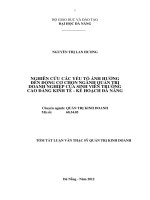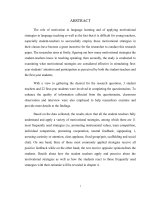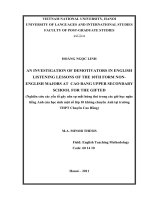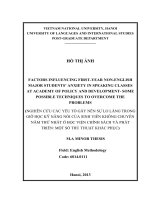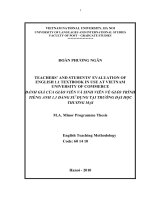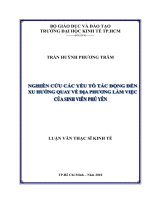Nghiên cứu các yếu tố gây nên sự lo lắng trong giờ học kỹ năng nói của sinh viên không chuyên năm thứ nhất ở Học Viện Chính Sách và Phát Triển
Bạn đang xem bản rút gọn của tài liệu. Xem và tải ngay bản đầy đủ của tài liệu tại đây (882.14 KB, 56 trang )
VIETNAM NATIONAL UNIVERSITY, HANOI
UNIVERSITY OF LANGUAGES AND INTERNATIONAL STUDIES
POST-GRADUATE DEPARTMENT
-------------------------------
HỒ THỊ ÁNH
FACTORS INFLUENCING FIRST-YEAR NON-ENGLISH
MAJOR STUDENTS’ ANXIETY IN SPEAKING CLASSES
AT ACADEMY OF POLICY AND DEVELOPMENT- SOME
POSSIBLE TECHNIQUES TO OVERCOME THE
PROBLEMS
(NGHIÊN CỨU CÁC YẾU TỐ GÂY NÊN SỰ LO LẮNG TRONG
GIỜ HỌC KỸ NĂNG NĨI CỦA SINH VIÊN KHƠNG CHUN
NĂM THỨ NHẤT Ở HỌC VIỆN CHÍNH SÁCH VÀ PHÁT
TRIỂN: MỘT SỐ THỦ THUẬT KHẮC PHỤC)
M.A MINOR THESIS
Field: English Methodology
Code: 6014.0111
Hanoi, 2013
VIETNAM NATIONAL UNIVERSITY, HANOI
UNIVERSITY OF LANGUAGES AND INTERNATIONAL STUDIES
POST-GRADUATE DEPARTMENT
-------------------------------
HỒ THỊ ÁNH
FACTORS INFLUENCING FIRST-YEAR NON-ENGLISH
MAJOR STUDENTS’ ANXIETY IN SPEAKING CLASSES
AT ACADEMY OF POLICY AND DEVELOPMENT- SOME
POSSIBLE TECHNIQUES TO OVERCOME THE
PROBLEMS
(NGHIÊN CỨU CÁC YẾU TỐ GÂY NÊN SỰ LO LẮNG TRONG
GIỜ HỌC KỸ NĂNG NĨI CỦA SINH VIÊN KHƠNG CHUN
NĂM THỨ NHẤT Ở HỌC VIỆN CHÍNH SÁCH VÀ PHÁT
TRIỂN: MỘT SỐ THỦ THUẬT KHẮC PHỤC)
M.A MINOR THESIS
Field: English Methodology
Code: 6014.0111
Supervisor: Nguyễn Thị Ngọc Quỳnh, Ph.D
Hanoi, 2013
DECLARATION
I hereby declare that this thesis is entirely my own work. I have provided fully
documented references to the work of others. The material in this thesis has not
been submitted for assessment in any other formal course of study.
Hanoi, September 2013
Signature
Hồ Thị Ánh
i
ACKNOWLEDGEMENT
I would like to show my sincere appreciation to many people who supported me to
complete this present study.
Firstly, I would like to express my deepest gratitude to my respectful supervisor,
Ph.D. Nguyễn Thị Ngọc Quỳnh, who provided me with a lot of professional advice
on the thesis writing. I am really grateful to her kind consideration, tender guidance,
critical feedback and insightful suggestions. Without her care, I could not have been
able to finish this study.
Secondly, I am also grateful to all the lecturers of the Post-Graduate Department of
University of Languages and International Studies, Vietnam National University
Hanoi for their valuable teaching and assistance during my course.
Thirdly, I would also like to acknowledge my gratefulness to the participants of this
study: the first – year students at Academy of Policy and Development. Without
their willingness to complete the questionnaires and participate in the interviews,
this study could not have been conducted.
Finally, I wish to express my deep thanks to my dear family, especially my older
sister for their love, encouragement, immeasurable support and concrete help for me
to complete this research.
ii
ABSTRACT
Feeling anxiety, apprehension are common phenomena experienced by foreign
language learners, especially in learning to speak a foreign language. These
negative feelings are blamed to exert detrimental effect on communication in the
target language. This current research, therefore, was conducted with the aim to
investigate main factors of speaking anxiety phenomenon in the first year students
at Academy of Policy and Development (APD). The study involved 50 students
from 5 first-year classes at APD. Through the use of quantitative (questionnaires)
and qualitative (semi-structured interviews) methods as research instruments and six
sources of language anxiety as theoretical guideline for data collection and analysis,
major findings were drawn. First, the speaking anxiety tendency of the students
surveyed was obvious. Second, some factors believed to contribute to students‟
anxiety were also identified, among which the personal and interpersonal anxieties
seemed to be most highly regarded by the students. Several pedagogical strategies
of these findings were offered to assist instructors in helping learners acknowledge,
cope with, and reduce anxiety, as well as to encourage them to make the learning
context less stressful to their students.
iii
TABLE OF CONTENT
INTRODUCTION .............................................................................................................. 1
1.
2.
3.
4.
5.
6.
RATIONALE ................................................................................................................ 1
AIMS OF THE STUDY .................................................................................................. 2
RESEARCH QUESTIONS .............................................................................................. 2
SCOPE OF THE STUDY ................................................................................................ 2
METHODS OF THE STUDY ......................................................................................... 2
DESIGN OF THE STUDY .............................................................................................. 3
CHAPTER I: LITERATURE REVIEW ........................................................................... 4
1. THEORETICAL BACKGROUND OF ANXIETY ................................................................... 4
1.1. Definition of anxiety .............................................................................................. 4
1.2. Types of anxiety...................................................................................................... 4
1.3. Foreign language anxiety ...................................................................................... 5
1.4. Effect of anxiety on Foreign Language Learning................................................ 6
1.5. Sources of foreign language anxiety ..................................................................... 7
1.6. Anxiety management strategies:.......................................................................... 11
2. SPEAKING ..................................................................................................................... 13
2.1. Definition of speaking.......................................................................................... 13
2.2. Roles of speaking in language teaching and learning ....................................... 14
CHAPTER II: METHODOLOGY .................................................................................. 15
1. SETTING ....................................................................................................................... 15
2. PARTICIPANTS ............................................................................................................. 15
3. DATA COLLECTION ...................................................................................................... 16
3.1. Instruments .......................................................................................................... 16
3.2. Data collection procedure .................................................................................... 17
4. DATA ANALYSIS: .......................................................................................................... 18
CHAPTER III: DATA ANALYSIS AND FINDINGS ................................................... 19
1. SOURCES OF FOREIGN LANGUAGE ANXIETY ............................................................... 19
1.1. Personal and interpersonal anxiety..................................................................... 19
1.2. Learner beliefs about language learning ............................................................ 21
1.3. Instructor beliefs about language teaching ........................................................ 23
1.4. Instructor-learner interactions ............................................................................ 26
1.5. Classroom procedures .......................................................................................... 29
iv
1.6. Language testing .................................................................................................. 31
CHAPTER IV: DISCUSSION AND CONCLUSION .................................................... 33
1.SUMMARY OF THE STUDY
2.SOLUTIONS
2.1. SOLUTIONS RELATED TO PERSONAL AND INTERPERSONAL ANXIETY ..................... 34
2.2. SOLUTIONS RELATED TO LEARNER BELIEFS ABOUT LANGUAGE LEARNING ........... 35
2.3. SOLUTIONS RELATED TO INSTRUCTOR BELIEFS ABOUT LANGUAGE TEACHING ..... 36
2.4. SOLUTIONS RELATED TO INSTRUCTOR-LEARNER INTERACTIONS .......................... 36
2.5. SOLUTIONS RELATED TO CLASSROOM PROCEDURES .............................................. 38
2.6. SOLUTIONS RELATED TO LANGUAGE TESTING ........................................................ 38
3. LIMITATIONS OF THE STUDY .............................................................................. 39
4. RECOMMENDATIONS FOR FURTHER STUDIES ............................................. 39
REFERENCES .................................................................................................................. 40
APPENDIX 1 ........................................................................................................................I
APPENDIX 2 ..................................................................................................................... IV
v
INTRODUCTION
1. Rationale
Learning a second language seems to be exciting for many people while others
struggle and even fail to achieve their desired level of language proficiency. It is
believed that second language acquisition (SLA) is determined and affected by
many different factors. Since the ground- breaking research of the Canadian
psychologists R.C. Gardner and Wallace Lambert about attitudes and motivation in
second language learning in the 1970s, SLA researchers have also considered
affective or emotional variables and how these factors may facilitate or hinder
language acquisition (Horwitz, Tallon, & Luo, 2010, p. 95). Among various
affective variables like attitude, anxiety, interest, motivation, inhibition, and selfesteem, “anxiety is quite possibly the affective factor that most pervasively
obstructs the learning process” (Arnold & Brown, 1999, cited in Dornyei, 2005, p.
198). As a result, Foreign Language Anxiety (FLA) has been gradually becoming
the research focus and interest of many language professionals as well as educators.
They have provided detailed understanding of FLA from different aspects:
theoretical models and frameworks of FLA (e.g., Tobias, 1977; Horwitz et al.,
1991; MacIntyre & Garner, 1994a, 1994b); sources and characteristics of FLA (e.g.,
Horwitz,1988; Koch & Terrell,1991; Young 1991); FLA effects on FL proficiency
and performance ( e.g., Kleinman, 1977; Madsen, 1982; Young, 1986); and anxiety
management strategies (e.g., Long & Porter, 1985; Price, 1991; Young, 1991).
Although a large number of studies in FLA have been carried out to investigate the
nature of FLA, to the best of the author‟s knowledge, little has been done on anxiety
experienced by Vietnamese learners in their English learning process.
In Vietnam, English has been now widely taught in almost all educational
institutions, at every level. Thus, learning English in Vietnam has gained a
remarkable achievement. However, in comparison with other developed countries,
learning speaking skill in Vietnam is not really efficient. As a teacher of English at
1
Academy of Policy and Development (APD), from her own observations and
experience, the present researcher has noticed that the feeling of anxiety,
apprehension and nervousness are common phenomena experienced by her first year students. Notably, the level of anxiety has been observed to be higher in
speaking classes compared with other ones, therefore, the outcome of oral English
speaking is not satisfactory. These negative emotional factors seem to maintain a
barrier that prevents students from actively participating in speaking activities. Such
situation has aroused her interest and inspired the author to conduct a research on
the topic: “Factors influencing first-year non-English major students’ anxiety in
speaking classes at Academy of Policy and Development- Some possible techniques
to overcome the problem”.
2. Aims of the study
The aim of the study is to find out the main causes that make first - year students at
Academy of Policy and Development stressful and anxious in speaking English
classrooms and then suggest some possible techniques for dealing with students‟
anxiety in speaking classes.
3. Research questions
The study is carried out with an attempt to answer the following question:
What are the main factors influencing first year non - English major
students’ anxiety in speaking classes at APD? What is the most common factor?
4. Scope of the study
FLA exists in the process of learning all the four skills: listening, reading, speaking
and writing (Aida, 1994; Horwitz, Horwitz & Cope, 1986; Young, 1986; Cheng,
Horwitz & Schallert, 1999; Cheng, 2002; Saito et al., 1999; Vogely, 1998).
However, this study only focuses on anxiety of speaking skill with its causes as
speaking is the best in expressing the students‟ participation as well as their
feelings. For its strong evidence- bearing capacity, speaking is chosen as a major
indicator to measure participation. Moreover, due to the time constraints, this study
only involves a small number of APD students in their first academic year.
5. Methods of the study
2
The data serving the research analysis are collected by using both quantitative and
qualitative methods. A survey questionnaire for informants of 50 first- year non
majors of English at Academy of Policy and Development was used to gather
information and evidence for the study. In addition, to gain more in-depth
information of the issue, semi- structured interviews with the informants were also
applied.
6. Design of the study
The study consists of three parts:
Introduction presents the rationale, the aims, the research question, the scope, the
method and the design of the study.
+ Chapter I: Literature Review provides the basic theoretical background from
literature in terms of speaking, foreign language anxiety in general and speaking
anxiety in particular. Especially, the effect and possible causes of anxiety, which are
the main issues of the study, are discussed thoroughly in this chapter.
+ Chapter II: Methodology deals with the overall picture of how the research was
carried out.
+ Chapter III: Data Analysis and Findings interprets the answer of research
question: What are the main factors influencing first year non - English major
students‟ anxiety in speaking classes at APD? What is the most common factor?
The findings of potential sources of speaking anxiety are reported and discussed in
this chapter.
+ Chapter IV: Dicussion and Conclusion summarizes the main contents and
findings of the study as well as the limitations of the study and suggestions for
further study and suggests possible techniques for both teachers and students with
an aim to reduce and cope with anxiety in speaking classes.
3
CHAPTER I: LITERATURE REVIEW
1. Theoretical background of anxiety
1.1. Definition of anxiety
Anxiety, one of the most prominent and pervasive emotions has been a focus
of research in foreign language learning since early 1970s. In the twentieth century,
May (1977) thought of anxiety as the apprehension cued off by a threat to some
value that the individual holds essential to his existence as a personality (p. 205).
According to Horwitz et al. (1986), anxiety is “the subjective feeling of tension,
apprehension, nervousness, and worry consisted of an arousal of the autonomic
nervous system”. “Anxiety is a psychological construct, commonly described by
psychologists as a state of apprehension, a vague fear that is only indirectly
associated with an object” (Hilgard, Atkinson, & Atkinson, 1971 cited in Scovel,
1991: 18). Anxiety refers to an emotional state that can have both positive and
negative influences, and which fosters and facilitates or disturbs and impedes
learning (MacIntyre, 1995).
To sum up, we find that anxiety is a complex psychological construct,
difficult to precisely define as it arises from many sources. In general, it can have
physical, emotional, and behavioral manifestations and these manifestations can
differ with each individual.
1.2. Types of anxiety
MacIntyre and Gardner (1991b) identified three perspectives to the study of
anxiety, which are: trait anxiety, state anxiety, and situation-specific anxiety. Trait
anxiety, a motive or acquired behavioral disposition that predisposes an individual
to perceive a wide range of objectively non-dangerous circumstances as threatening,
and to respond to these circumstances with anxiety state reactions disproportionate
in intensity to the magnitude of the objective danger, is relatively permanent and
steady personality feature (Spielberger, 1966). State anxiety is apprehension
experienced at particular moment in time, for example, prior to taking exams. This
4
anxiety can be provoked in the confrontation of the perceived threat (MacIntyre &
Gardner, 1991b). However, it is temporary and altered in time. In order to attribute
the experience to a particular source, researchers adopt situation- specific
perspective to the study of anxiety. This perspective examines anxiety reactions in a
“well-defined situation” such as public speaking, during tests, when solving
mathematics problems, or in a foreign language class (MacIntyre & Gardner,
1991b, p. 90). Specific situations can offer more understanding to particular anxiety
in diverse situations.
1.3. Foreign language anxiety
Anxiety has been found to interfere with many types of learning but when it
is associated with leaning a second or foreign language it is termed as
„second/foreign language anxiety‟. It is a complex and multidimensional
phenomenon (Young, 1991: cited in Onwuegbuzie et al., 1999: 217). According to
Horwitz, Horwitz, and Cope (1986), foreign language anxiety belongs to situationspecific anxiety, which refers to the apprehension experienced when a situation
requires the use of a second language with which the individual is not fully
proficient (Gardner & MacIntyre, 1993).
Horwitz et al. (1986, p. 128) defines foreign language anxiety as “ a distinct
complex of self-perceptions, feelings, and behaviors related to classroom learning
arising from the uniqueness of the language learning process” and Gardner and
MacIntyre (1993, cited in Arnold 1999:59) portraits language anxiety as “fear or
apprehension occurring when a learner is expected to perform in the second or
foreign language.”
Researchers have been unable to draw a clear picture of how anxiety affects
language learning and performance (Horwitz and Young, 1991: xiii). Some
researchers reported a negative relationship between language anxiety and
achievement. However, anxiety has occasionally been found to facilitate language
learning. Therefore, it is important that FL researchers and teachers understand
5
better the nature of FLA in order to find out effective teaching methods to reduce
the negative effects of anxiety.
1.4. Effect of anxiety on Foreign Language Learning
Most language FL researchers have focused on investigating the relationship
between anxiety and language learning. Although the results conflict, language
anxiety displays the negative effects in most cases (Chan and Wu, 2004, p. 291).
According to MacIntyre and Gardener (1991b), anxiety has been found to
negatively affect performance in the second language. In this sense, anxiety, in
variety of studies, has displayed significantly negative correlations with students'
performances in terms of final course grades (Aida, 1994; Horwitz, Horwitz, &
Cope, 1986; Liao, 1999), standardized tests (Gardner, et al., 1987), and the grades
in mid-term exams (Liao, 1999). In addition, anxiety motivates the learner to
withdraw from the language task and leads him to adopt avoidance behaviours
(Alpert & Haber, 1960; Scovel, 1978). Horwitz et al. (1986) claims that highly
anxious students avoid conveying complex messages in the foreign language, or
take more time to learn vocabulary items (MacIntyre & Gardner, 1989). Moreover,
MacIntyre and Gardner (1991b) found out that if the student‟s experience and
proficiency increase, anxiety declines in a fairly consistent manner. In contrast, if
their proficiency and experiences with the foreign language are not positive, foreign
language anxiety develops. Poor foreign language performance reinforces foreign
language anxiety. As a result, these two variables affect each other constantly.
Furthermore, almost all studies nowadays have shown that in the three stages of
language acquisition, that is, input, processing and output negatively correlated with
anxiety (Horwitz et al., 1986; Tobias, 1986; Price 1991; MacIntyre & Gardner
1991a; Ellis, 1994). Besides, there have been some studies conducted to point out
the negative relationship between anxiety and four aspects of language learning,
especially, speaking and listening. MacIntyre and Gardner (1991) further claims
6
that speaking is by far the main agent of anxiety- arousal, and that students with
high anxiety perform worse than those with low anxiety.
However, although a certain level of anxiety may be detrimental, some
researchers found positive correlations between foreign language anxiety and
language achievement, e.g. anxiety “motivates the learner to „fight‟ the new
learning task; it gears the learner emotionally for approach behavior” (Scovel, 1991,
cited in Tanveer, 2007, p. 11) or it is believed to enhance the learning process
(Alpert & Haber, 1960; Kleinman, 1977). Additionally, in Bailey‟s (1983) study of
competitiveness and anxiety, it was found that anxiety was one of the keys to
success, and closely related to competitiveness. It means that in active learning
atmosphere, students‟ anxiety will make them feel passive, reticence when taking
part in speaking activities in groups, pairs or responding the teachers. Consequently,
their achievements are not good, so they have to deal with the problem by many
ways in order to overcome it.
On the whole, the researchers agree that the relationship between anxiety and
language learning is probably not a simple linear one. Therefore, it is important that
FL researchers and teachers understand better the nature of FLA in order to find out
effective teaching methods to reduce the negative effects of anxiety.
1.5. Sources of foreign language anxiety
According to Horwitz, Howtitz and Cope (1986), while learning a foreign
language, approximately one-third learners experience some types of foreign
language anxiety. Researchers had indicated that, there are a number of factors that
can cause anxiety for language learners. Horwitz, Horwitz and Cope (1986) claim
that students were anxious in ESL/ EFL classroom due to communication
apprehension, test anxiety, and fear of negative evaluation. Bailey (1983) concluded
from his studies and interviews that competitiveness, tests and learners‟ perceived
relationship with their teachers are all possible causes of anxiety. Another
conclusion was supported by Price (1991) that language anxiety originated from 4
aspects: difficulty level of foreign language classes, personal perception of language
7
aptitude, certain personality variables and stressful classroom experiences. Through
a review of the literature on language anxiety, Young (1991) also offers an
extensive list of six potential sources of language anxiety. He claims that language
anxiety can be broken down into six main sources: personal and interpersonal
anxiety, learner beliefs about language learning, instructor beliefs about language
teaching, instructor-learner interactions, classroom procedures, and language
testing. The author will in turn discuss the six potential sources of language anxiety
below.
1.5.1. Personal and interpersonal anxieties
According to Young (1991), personal and interpersonal anxieties are the
most commonly cited potential sources of language anxiety. He also supposed that
personal anxiety is in relation to learners‟ personality traits ( e.g., shyness,
reservedness) or individual differences ( e.g., self- esteem, self- perception),
meanwhile, interpersonal anxiety is concerned with situation- specific anxiety ( e.g.,
competitiveness, fear of negative evaluation, communication apprehension).
Several researchers argued that low self-esteem and competitiveness are
the two significant sources caused learners‟ anxiety. Price (1991) and Hembree
(1988) implied that learners who start out with a self- perceived low ability level in
a foreign or second language are more likely to feel language anxiety. Students
with low self- esteem tend to worry about what their peers or friends think, in fear
of their negative responses or evaluation as they express their self image through a
FL (Bailey, 1983; Price, 1991; Young, 1991). As regards to competitiveness, Price
(1991) stated that many of her subjects see themselves as “less proficient than other
objects of comparison” and that they "weren't doing a good job and that everyone
else looked down on them.” Likewise, Bailey (1983) analyzed the diaries of 11
learners and found that competitiveness can lead to anxiety when language learners
compare themselves to others or to an idealized self-image.
In addition, Gergerson and Horwitz (2002) have discovered the link between
anxiety and perfectionism and found some common characteristics between anxious
8
language learners and perfectionists (e.g., higher standards for their English
performance, more worry over the opinions of others, and a higher level of concern
over their errors). These things seem to make language learning unpleasant and less
successful for the perfectionist students than for others.
1.5.2. Learner beliefs about language learning
Unrealistic and erroneous learner beliefs about language learning are also a
major factor contributing greatly to creating language anxiety in students (Young,
1991, p.428). In his study, Horwitz (1988) found that over one- third of the students
believed that foreign language learning primarily involved translating from English
and memorizing vocabulary words and grammatical rules. Additionally, many
students also thought that success of L2 learning limited to a few individuals who
are gifted for language learning. Gynan (1989) conducted a similar study and
reported that some learners believe that pronunciation is the most important aspect
of L2 learning. Some others prefer other learning practices, such as vocabulary,
translation, communication, traveling to a country where the language is spoken, or
making friends. As is apparent from these results, it is quite conceivable that such
erroneous beliefs may make the students later become disappointed and frustrated.
For instance, if beginning learners believe that pronunciation is the most important
aspect of L2 learning, they will naturally get frustrated when failing to produce
perfect speech even after a lot of practice. All of those faulty beliefs can play
another major role in forming language anxiety.
1.5.3. Instructor beliefs about language teaching
Instructor beliefs about language teaching can also become a source causing
language anxiety because the teacher's assumption about the role of language
teachers may not always correspond to the student's needs or expectations toward
the him or her (Ohata, 2005, p. 7). For example, when a teacher believes that his
role in class is to constantly correct students' errors, some of the students might
9
become quite anxious about their class performance. Young (1991, p.428) stated
that the following teacher beliefs are associated to students‟ anxiety: a little bit of
intimidation is a necessary, the instructor is supposed to correct every single
mistake made by the students, group or partner work is not appropriate because it
can get out of control; the teacher should do most of the talking; and the instructor‟s
role is that of a drill sergeant. Similarly, a judgmental teaching attitude (Samimy,
1994) and a harsh manner of teaching (Aida, 1994) have been shown to evoke
feelings of anxiety.
1.5.4. Instructor-learner interactions
Another constituent cause of anxiety is the relationship between instructor
and learner which is closely related to a harsh manner of mistake correction. Many
learners feel that some error correction is necessary (Koch & Terrell, 1991;
Horwitz, 1988) and they are more concerned about how (i.e., when, what, where, or
how often, etc.) their mistakes are corrected rather than whether error correction
should be administered in class. In addition, the following characteristics of the
teacher such as absence of teacher support, unsympathetic personalities, lack of
time for personal attention, favoritism, the sense of being judged by the teacher or
wanting to impress the teacher are also in relation to anxiety (Palacios, 1998).
Moreover, Ando (1999) argued that having a native speaker for a teacher can cause
anxiety because the teacher may lack the sensitivity of the learning process or the
teacher‟s English may be hard for students to understand.
1.5.5. Classroom procedures
Classroom procedures or class activities are also counted another source of
foreign language learning anxiety. Young (1990) proposed a list of classroom
activities which are perceived as anxiety-provoking:
o spontaneous role-play in front of the class
o speaking in front of the class;
o oral presentations or skits in front of the class;
o Presenting an unprepared dialogue in front of the class; and
10
o Writing work on the board.
Palacios (1998) found demands of oral production, feelings of being put on the spot,
the pace of the class, and the element of being evaluated (i.e., fear of negative
evaluation) to be anxiety- provoking source. Another practice that was cited as a
potential source of language anxiety by the students concerned calling on students
one after another in seating order in the speaking classes. These practices would
frequently cause language anxiety for students.
1.5.6. Language testing
This can be a further source causing foreign language anxiety (Young, 1991)
which “refer to a type of performance anxiety stemming from a fear of failure”
(Horwitz et al, 1986). For example, difficult tests, especially tests that do not match
the teaching in class, as well as unclear or unfamiliar test instructions can all create
learner anxiety.
According to Young (1991), these six sources of language anxiety discussed
above are interrelated. Therefore, language teachers should be fully aware of these
sources to lessen FLA in their students.
1.6. Anxiety management strategies:
Many researchers, such as MacIntyre (1991a), Young (1991a), Phillips (1999),
Foss and Reitzel (1988), Price (1991), have consistently attempted to elaborate
teaching and in- class techniques to overcome and cope with students‟ speaking
anxiety. In relation to six potential sources of language anxiety offered by Young
(1991), this section is designed to outline a series of strategies identified by
researchers for alleviating language anxiety, some of which are associated with the
learner characteristics, some with the teacher characteristics, and others with the
classroom procedures.
Firstly, to reduce anxieties related to personal and interpersonal anxieties as
well as erroneous learner beliefs about language learning, Young (1991)
recommends verbalization of any fears as a way to cope with language anxiety. The
teachers ask students to write their fears or anxieties on the blackboard in order to
11
share them with their peers in the class (Foss & Reitzel, 1988). This might be an
effective method as students can be aware of the fact that they are not alone in their
worries and they can see that language anxiety particularly in speaking is a frequent
phenomenon. Additionally, the technique adopted by Foss and Reitzel (1988) is
interesting, that is using an anxiety graph in order to for students to recognize level
of anxiety of a given interaction. To deal with anxieties stemming from learner‟s
personality, Young (1990) suggested that providing supplemental instruction or a
support group is clearly an effective way. For anxieties derived from students‟
erroneous beliefs, teachers should “discuss with their students reasonable
commitments for successful language learning and the value of some language
ability if it is less than fluent” (Horwitz, 1988, p. 286).
Secondly, it is necessary to consider some solutions to deal with anxieties
associated with instructors‟ beliefs and teacher- student interactions. Regarding
teachers‟ beliefs, Phillips (1999) suggests the administration of foreign language
scales such as the the Foreign Language Anxiety Scale (FLCAS) (Horwitz et al.,
1986) and the Beliefs About Language Learning Inventory (BALLI) (Horwitz,
1988) to language teachers should be used to understand their viewpoints. Besides,
Young (1991) proposes that teacher needs to be aware that his role is that of a
“facilitator” (p. 431) who gives regular information about language learning. The
teachers should focus exclusively on “student- student interactions” rather than
“teacher-student communication”, and put the emphasis on “…conveying meaning
rather than underscoring mistakes” (Phillips, 1999, p. 144). To decrease anxieties
stemming from teacher- student interaction, Young (1991) suggests that it is
important to create an in-class environment where the learners feel more at ease.
The atmosphere must consist of “mutual acceptance and mutual respect, where
students know how to appreciate other students, teachers appreciate students, and
students appreciate the teacher.” (Young, 1999, p. 5). Additionally, Young (1990)
found that the students felt more at ease when the instructors deal with corrections
in non- threatening manners and when they are friendly, humorous and patient.
12
Therefore, it can also be suggested that equal relationship between teacher and
student is an important aspect to reduce language classroom anxiety.
Thirdly, to lessen anxieties caused by classroom procedures, Young (1990)
offers some useful suggestions: using more student to student interaction in pairs or
small groups, role-playing with preparatory activities to instill class rapport, playing
language games with an emphasis on problem-solving. These in – class practices
will emphasize on interactions, conversations and language use (Lightbown &
Spada, 1993) and make language learning enjoyable and more comfortable. Another
method to reduce language anxiety is the participation to certain language clubs or
extra curriculum activities, where the practice of self–talk could be central (Young,
1991, p.431). To cope with language testing anxieties, Young (1991) believes that
teachers should consider the use of fair and comprehensive tests that accurately
affect what has been instructed in the class.
In conclusion, there is a broad range of methodologies developed by
researchers to cope with students‟ language speaking anxiety and to improve their
language competence. The great consideration has been showed toward the
strategies adopted by learners and the teachers should aware of these instructional
techniques to reduce the amount of worry and fear experienced by students.
2. Speaking
2.1.
Definition of speaking
Speaking has been defined differently by a lot of researchers. Brown (2001) defined
speaking as “spoken language consists of short, fragmentary utterance, in range of
pronunciation. There is often a great deal of repetition and overlap between one
speaker and another, and speaker use non- specific references.” Florez (1999) refer
to speaking as “an interactive process of constructing meaning that involves
producing and receiving and processing information.” (cited in Balley, 2005, p. 2).
According to Bygate (1997), speaking was a skill which is often thought of as a
“popular” form of expression that uses the unprestigious “colloquial” register.
Speaking is in many ways an undervalued skill. Mackey (1965) stated that speaking
13

